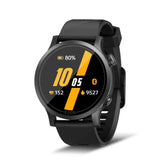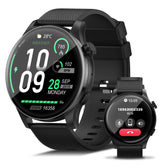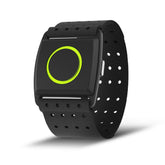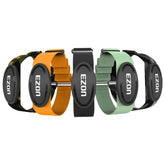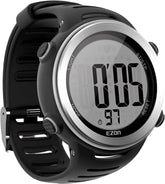運動中の健康的な心拍数を理解する
運動中の健康的な心拍数を理解する
最高のパフォーマンスを達成し、健康を維持するには、運動中の心拍数を把握することが重要です。ランニングで舗装道路を走る場合でも、ジムでウェイトトレーニングをする場合でも、理想的な心拍数を知っておくと、トレーニングを最適化し、フィットネス目標を達成するのに役立ちます。この記事では、さまざまなタイプの運動の理想的な心拍数の範囲、これらの心拍数に影響を与える要因、 心拍数モニターウォッチを使用して進捗状況を効果的に追跡する方法について説明します。
心拍数とは何か?なぜ重要なのか?
心拍数とは、1 分間に心臓が鼓動する回数 (bpm) を指します。心血管の健康状態を示す重要な指標であり、身体活動中に体がどの程度激しく動いているかを知る手がかりとなります。心拍数をモニタリングすることで、安全かつ効果的な範囲内で運動しているかどうかを確認し、パフォーマンスを最大限に高め、怪我のリスクを最小限に抑えることができます。
さまざまな運動における理想的な心拍数の範囲
1. 有酸素運動
ランニング、サイクリング、水泳などの有酸素運動では、主に酸素を使って筋肉にエネルギーを供給します。これらの運動の理想的な心拍数は、通常、最大心拍数 (MHR) の 50% ~ 85% の範囲です。MHR を計算するには、次の式を使用します。
MHR = 220 - あなたの年齢
たとえば、あなたが 30 歳の場合、MHR は 190 bpm になります。したがって、有酸素運動の目標心拍数ゾーンは 95 bpm (MHR の 50%) から 162 bpm (MHR の 85%) の間になります。
2. 無酸素運動
短距離走や重いウェイトリフティングなどの無酸素運動では、短時間のエネルギーの爆発が必要で、通常は心拍数が高くなります。無酸素運動の目標心拍数ゾーンは通常、MHR の約 80% ~ 90% です。前述の 30 歳の例を使用すると、高強度のトレーニング中の心拍数は 152 bpm ~ 171 bpm になります。
心拍数に影響を与える要因
運動中の心拍数に影響を与える要因はいくつかあります。
- 年齢: 年齢を重ねるにつれて、最大心拍数は通常低下します。
- フィットネス レベル: 体調のよいアスリートは、安静時の心拍数が低く、運動中の心血管反応がより効率的である可能性があります。
- 水分補給と栄養: 脱水と栄養不足は心拍数の上昇につながる可能性があります。
- ストレスと不安: 感情的な状態も心拍数に影響を与え、安静時でも心拍数が上昇することがあります。
心拍数モニターウォッチの使用
トレーニング中に心拍数を効果的に追跡するには、信頼性の高い心拍数モニターウォッチを購入することが不可欠です。心拍数モニターを使用する利点は次のとおりです。
- リアルタイム データ: 心拍数をリアルタイムで監視し、目標心拍数ゾーン内に留まるようにします。
- 進捗状況の追跡: 心拍数を時間の経過とともに記録し、心血管の健康状態の改善を観察します。
- パーソナライズされた洞察: 多くのスポーツウォッチには、トレーニング パターンを分析し、パーソナライズされたトレーニング プランを推奨する機能が搭載されています。
トレーニングに最適なスポーツウォッチの選び方
ニーズに最適な心拍数モニターウォッチを選択するときは、次の機能を考慮してください。
- 精度: 心拍数追跡の精度が実証されたモデルを探してください。
- バッテリー寿命: 特に長時間のトレーニングでは、時計のバッテリー寿命が長いことを確認してください。
- ユーザーフレンドリーなインターフェース: わかりやすいインターフェースにより、エクササイズ中に簡単にナビゲートしてデータにアクセスできます。
- 追加機能: 多くのスポーツウォッチは、GPS 追跡、睡眠モニタリング、フィットネス アプリとの統合などの機能を備えており、全体的なトレーニング体験を向上させます。
結論
さまざまな運動の理想的な心拍数の範囲を理解することは、トレーニングを最適化し、安全を確保するために不可欠です。年齢やフィットネス レベルなどの要素を考慮することで、目標に合わせてトレーニングを効果的に調整できます。高品質の心拍数モニター ウォッチに投資することで、パフォーマンスと進捗状況を追跡できるようになり、より健康的なライフスタイルに一歩近づくことができます。心臓の力を過小評価しないでください。心臓を監視し、理解し、フィットネスの旅で成功への道を歩んでください。
これらのガイドラインに従うことで、トレーニングを最大限に活用し、単に運動するだけでなく、長期的な健康とフィットネスを促進する方法で運動を行うことができます。
